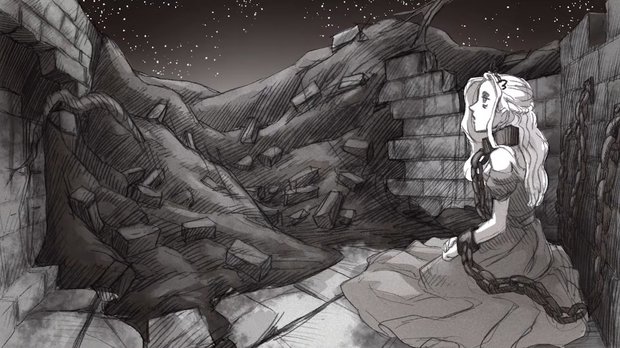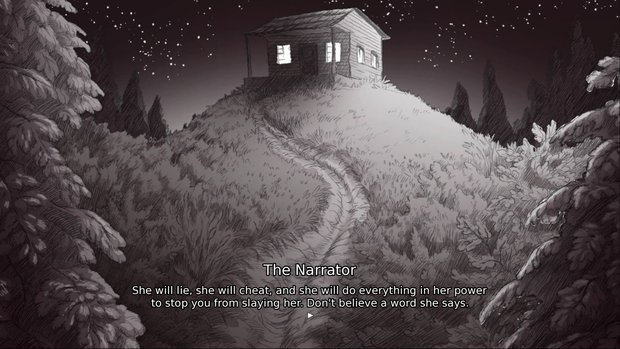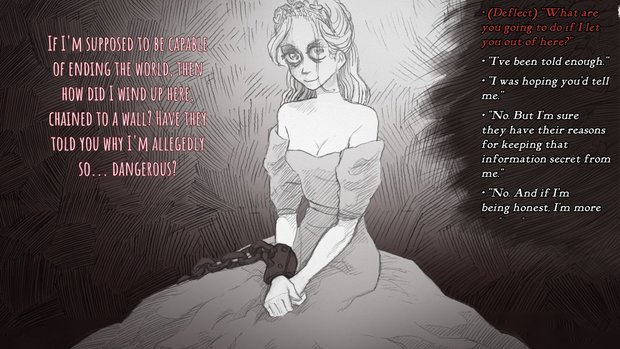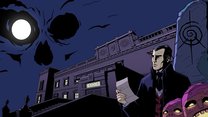Slay the Princess review

- 1 Comment
Subversive, brilliantly executed visual novel continually surprises with impactful player choice
Personally, I’ve never been opposed to a few spoilers here and there; I don’t go blabbing them to others who might feel differently, of course, but if knowing what happens really prevented us from enjoying ourselves, I don’t think we’d return to our favorites so often. (Go ahead, ask me how many times I’ve read The Hobbit.) Sometimes, though, a game comes along like Slay the Princess, where I’d like nothing more than to dive into the hows and whys of its many towering achievements … but where, if you’re to get everything out of it that I did, it’s imperative that you go in mostly blind. This is a game that elevates the unexpected to an art form, skillfully deploying moments of discovery, surprise, reversal, and revelation to get you both thinking about and feeling its central themes, and I wouldn’t dream of blunting the many wonderful stings in its tail.
What I will say up front about Slay the Princess is that it’s a staggeringly ambitious title and a deeply human one, by turns shocking, moving, and riotously funny. It’s an attempt to reckon with the many faces of love, the protean nature of identity, and what it truly means to choose between life and death. It’s many things: a brutal, visceral work of horror; a complex psychological study; an alchemical treatise; and always, always a love story. More than anything, though, it’s just an astoundingly good game.
Slay the Princess establishes the basics right off the bat: as the unseen Narrator tells you, there’s a Princess locked in a basement in the woods, and unless you kill her, the world will end. Why you? Why her? Why any of this? None of that matters. You have all the information you need; choose what to do. It’s a straightforward, one-or-the-other decision.
But it isn’t, really, is it? Because first you have to decide whether that is enough information. Should you ask the Narrator some follow-up questions? Can you trust what he says? If not, what do you do about it? Go ahead anyway and hope to figure it out on the fly? Ask the Princess for her side of the story? What if she just says what she thinks you want to hear? Should you explain why you’re here and hope for honesty in return, or feign innocence and see if she lets something slip? What if you just wash your hands of the whole thing and depart, leaving the problem for someone else?

These are just a few decisions out of several hundred that Slay the Princess might throw at you in a single six-hour playthrough, and each carries consequences that can suddenly and radically reshape your circumstances. Every choice you make propels the game forward into stranger and more unexpected territory, the narrative cascading and building momentum as it expands in ways you never could have guessed.
Beginning on a forest path, the Narrator explains the situation and gives you the opportunity to ask questions before you proceed to the cabin. Responding to and commenting alongside him is another Voice, that of the Hero, which to all appearances represents your character’s internal monologue. It is a bit strange, though, the way the Voice of the Hero sometimes speaks directly to the Narrator without your input, like they were conversing on their own. Even stranger are the moments when the Voice of the Hero speaks directly to you, the player. And, hang on, what does it mean, referring to “the three of us here?” If the Voice of the Hero isn’t your voice, whose is it? And who are you?
It’s the first overt sign that the situation may be more complex than the Narrator lets on, and that additional rules, as yet unknown, might be in play. Such signs continue to mount as you proceed: occasional glimpses of your character’s limbs, for instance, inspire questions without immediate answers. Still, you’re at complete liberty to investigate or ignore these dangling threads as you see fit; freedom of choice is the name of the game here, and as the Narrator is quick to remind you, nobody can make you do anything.
Except, of course, when they can.

Slay the Princess controls like a visual novel: you’ll select actions and conversations alike from a dialogue box at the side of the screen, at which point the Narrator dutifully describes how your choice plays out, the slideshow-style visuals change to match, and the story proceeds. While this places technical limits on your freedom to decide—you can only choose those options the developers imagined for you—it feels in practice like no restriction at all; Black Tabby Games has done a lot of imagining. On the first screen alone, in the game’s first minute, you have seventeen options to choose from, including questions for the Narrator, declarative statements, and actions you might take. Early on, very few of these will lock you out from selecting the others; options that let you gather information before deciding what step to take next are marked helpfully with “[Explore].”
What sets Slay the Princess apart from so many other titles where “choices matter” is the way it molds its narrative to account for each decision. Selecting a course of action, like picking up a knife instead of leaving it where it is, doesn’t simply determine whether you have a knife in the next scene; it changes the very core of the story that follows. You didn’t just take the knife—you told the game that this character, who you’re playing as now, is the kind of person who would take that knife, and what comes next will be tailored with that in mind.
So, enter the basement with knife in hand and you’ll find the Princess guarded, defiant, with her bearing stiff and an edge to her voice; proceed unarmed and she’ll appear frightened, vulnerable and desperate to trust someone. The former scenario sees you engaging in a cautious conversational duel, full of verbal feints and attempts to catch one another off guard; in the latter, the mood is less tense, with you and your apparent target on a more equal footing. Each situation then blossoms outward, leading you down a totally different path than the opposite action would have, all the way through to conclusions that resemble each other only in their relevance to the game’s central themes of change, identity, and mortality.

Every choice you make, with few exceptions, carries this immense weight. You aren’t just determining what happens next, but the very nature of the story, and you’re doing it again, and again, and again. There are innumerable narrative threads open for you to follow within the game’s larger framework, with elaborately constructed mini-arcs that arise as you react and engage with new discoveries. Slay the Princess never skimps or tries to shunt you where it thinks you ought to go; no matter how you decide to act or what path you take, the results unfold organically, and the writing shines with the same high level of depth, polish and craft.
Such freedom means you can and will make choices that lead to your character’s grisly death. This isn’t as much of an impediment to your progress as you’d think: for reasons that appear unclear to everyone involved, being killed simply zaps you back to the forest path where you started, body and memories very much intact. Naturally, the story adapts around each fatality, so that death is just one more path forward.
Many forks in your road see new Voices arriving on-scene alongside the Narrator and the Hero. These include the Voice of the Smitten, whose dreamy paeans to love and passion stand in hilarious contrast to your grim surroundings; the Skeptic, who trusts nobody and takes nothing on faith; the Opportunist, who urges you to side with whoever seems likely to come out on top; and several others, for a total of twelve, all with their own unique cadences, personalities, and functions within the story.
Astoundingly, every one of the male Voices—Narrator, Hero, and all the rest—is brought to life by a single actor: Jonathan Sims, whose stellar work on his podcast The Magnus Archives earned my admiration years ago but which still left me unprepared for what he does here. This is much more than a Narrator swapping accents and rhythms to help distinguish between characters, or an actor affecting broadly different speech patterns to disguise his voice. What Sims does here is give twelve separate, distinct performances, frequently in active conversation with each other, without ever repeating the same trick twice.

While the subtitled dialogue is accompanied by a tag to let you know who’s speaking—necessary when new Voices are introduced—these swiftly become superfluous. No matter how many Voices show up to bicker, brainstorm and bark at each other, I never mistook one for another. The Smitten, with his lusty, full-throated declarations, sounds nothing like the hoarse, defeated Broken, for instance, and neither shares much in common with the Stubborn’s aggressive growl. Presiding over them all is the prim, punctilious Narrator, whose crisp, no-nonsense delivery calls to mind a surgeon taking impatient charge of an operating theater.
What version of the Princess you encounter depends on the story forks you follow; I was disappointed, but hardly surprised, to conclude that different actors voiced each of these incarnations. It would have been a lot to ask, I figured, for the developer to find two actors with Sims’s versatility … except that I was very wrong, and a single actor, Nichole Goodnight, does voice the Princess in all her guises. She’s just so good at adopting new personae that she fooled me all the way to the end credits.
Goodnight builds each of her performances around a different aspect of the Princess’s character—menace in one version, vulnerability in another, exuberance, heartbreak, and glee in still others—without ever losing sight of the many facets that together make up a person. No matter how threatening, unsettling, or monstrous she’s called on to be, the Princess never feels caricatured; even at her most inhuman, Goodnight manages to find and plumb her hidden depths.
Visually, Slay the Princess uses a static slideshow presentation common to many visual novels, but the writing, the performances, and the black-and-white art are all so evocative that I initially misremembered it as being fully animated. Simply put, the game feels alive, thanks in no small part to a staggering number of hand-drawn backgrounds that create the illusion of constant motion. It feels like stepping into a charcoal illustration from some eerie collection of Victorian fairytales. There’s a real sense of weight and dimension to each screen, with just enough stylized irreality around the edges to keep you off-balance. Cartoonish touches, like the Princess’s soft-edged silhouette and absurdly large eyes, give way abruptly to scenes of gory, hyper-detailed violence (accompanied by stomach-churning sound design). You’ll never feel entirely safe where you stand, or at all secure in your notion of what comes next—especially because of the many, many times you’re likely to die. Meanwhile, Brandon Boone’s dynamic synth soundtrack shifts and metamorphoses into new and surprising variations on the Princess’s melancholy, tinkling leitmotif to match new moods and circumstances as they arise.
If the game has one notable failing it’s simply that, for all it otherwise lets you wander a labyrinth of a hundred divergent paths, Slay the Princess seems unsure what to do with the one sequence that requires it (and you) to face forward and move in a straight line. This comes late in the game, when you finally have a chance to interrogate somebody with answers, and it’s clearly intended as a payoff moment that closes the book on several big questions. What you learn here is central to the game working as well as it does, and it’s crucial that you find it out somehow, but I couldn’t help wishing it arrived more organically. It’s a straightforward, no-frills infodump, meant to deliver exposition and not much more, and it would feel a bit creaky even in a more linear title; in this game, which has previously taken such pains to surprise, disarm, and subvert the player’s expectations, it feels underwhelming and anticlimactic. This isn’t a game well served by upending a big box marked ANSWERS.
Final Verdict
And it’s one hell of a game. None of which is to say that Slay the Princess fails to stick the landing—or landings, in this case, as there’s naturally more than one. As with everything else, the decisions you made affect where you end up, though you still have enough freedom to finally shape what exactly that looks like. Whatever happens, you’ll finish the game secure in the knowledge that you haven’t seen anywhere close to all it has to offer. You’ll likely be tempted, as I was, to dive right back in again and start it over. It’s full of horrors, yes, and violence, and the near certainty of failure, but in its boundless creativity, in the multifariousness of its narrative and its characters, and in its unflinching commitment to exploring the fullness of possibility, Slay the Princess is, more than anything, a cry of joy and wonder at the staggering beauty of not knowing what comes next.
Hot take
While Slay the Princess comes in a deceptively simple package, it contains what feels like a whole universe of horror, humor and humanity; it takes the visual novel format and pushes it as far as it will go, with a story that changes and adapts to every decision you make without ever forsaking its central themes of identity, eternity, and the nature of life and death.
Pros
- Constantly branching narrative with an incredible number of possibilities
- Superbly versatile voice acting achieved with only two phenomenal actors
- Player decisions truly matter, significantly altering the course of the story
- Powerful and fascinating narrative explores a variety of themes in creative and interesting ways
- Hand-drawn art is beautiful and atmospheric
- Gorgeous dynamic soundtrack
Cons
- Expository sequence near the end feels less elegant and satisfying than the rest of the game
- Not for the squeamish
Will played Slay the Princess on PC using a review code privided by the game's publisher.










1 Comment
Want to join the discussion? Leave a comment as guest, sign in or register in our forums.
Write-ups like this don't hurt my enthusiasm for this game. It's one of many in the queue for 2024.
Reply
Leave a comment